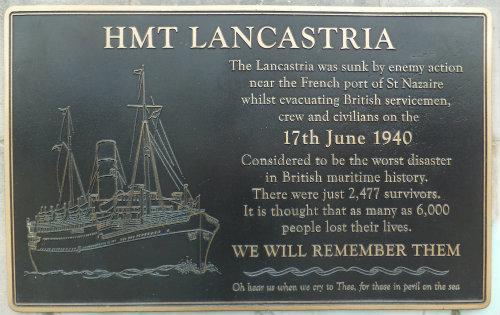HMT Lancastria remembered 75 years on


HMT Lancastria in the Second World War © IWM (N 375)
Of the many losses suffered by the Royal and Merchant Navies in the Second World War there is one which stands out for the sheer scale of the loss of life involved. The sinking of the HMT Lancastria is one of Britain’s worst Maritime disasters; she sank in less than twenty minutes, following a bombing attack, with the staggering loss of several thousand lives.
On 10 May 1940 German troops marched into Belgium, the Netherlands, Luxembourg, and finally France. British troops became stranded by German manoeuvres, cut off against the coast, and retreat via evacuation became imperative. The most famous of the evacuations was Dunkirk but it was by no means the only one. An estimated 140,000 British troops retreated towards Brittany and the ports around the Bay of Biscay on the west coast of France. The commander of the British forces quickly realised that here too evacuation was the only realistic option.
Wrist watch belonging to Lancastria survivor Sidney Dunmall. Accession number MMM.1998.145.4
This evacuation, codenamed Operation Ariel, would encompass over 210,000 servicemen, several thousand civilians, 2,292 military vehicles, 310 guns and 1,800 tons of stores, from the Channel Islands and the Bay of Biscay. It exceeded the most optimistic of expectations in its success; but this success was marred by the sinking of the HMT Lancastria, which marked the highest death toll for British Forces in a single engagement in the whole of the Second World War.
The Lancastria was a Cunard line ship, launched in 1920 under the name Tyrrhenia (she was later renamed Lancastria due to complaints from passengers that they could not pronounce Tyrrhenia) and requisitioned as part of the war effort in April 1940. She assisted in the evacuation of troops from Norway in May before being sent to aid in the evacuation of Western France.
On 17 June, off the French coast at Saint-Nazaire, she came under concentrated attack from German aircraft, while awaiting a Navy escort, before being hit by a stick of bombs. She sank within 20 minutes. Only two lifeboats had been launched when incendiary bullets from aircraft machine guns set fire to the floating fuel oil (more than 1,000 tons of it) that had spilt from the ship.
The death toll was horrific, it remains the highest for the sinking of any one ship in British history. Lancastria’s official capacity was around 2,200 including her crew but Captain Shaw had been told to load as many people on board as possible, such was the desperate nature of the evacuation. No one can be sure of just how many lives were lost in the attack; she had spent all the morning embarking as many people as she could and estimates range from there being 5,000 to 9,000 people on board, of which less than 2,500 survived.

Lancastria memorial plaque at Liverpool Pier Head.
The watch pictured above was worn during the sinking by survivor Sidney Dunmall and can be seen in the Maritime Museum’s Life at Sea gallery. It shows the time as ten minutes past three; the Lancastria sank at around 4.10pm local time, which would have been an hour earlier British time, so the watch may well mark the moment it (and its owner) went into the water.
Operation Ariel was a success but at the cost of the Lancastria and the thousands who died in the attack on her. Tp mark the 75th anniversary of the sinking and a special commemorative service is taking place at the local ‘Sailor’s Church’ of Our Lady and St Nicholas here in Liverpool at 10.30am on Saturday 13 June 2015. Anyone who would like to attend will be very welcome.

